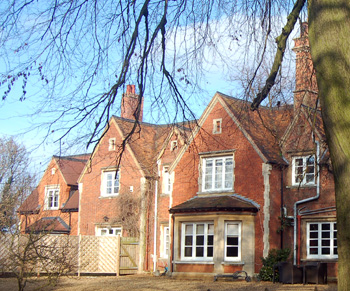Ridgmont Vicarage
![The Vicarage about 1900 [Z50/95/41]](/CommunityHistories/Ridgmont/RidgmontImages/The Vicarage about 1900 [Z50-95-41].jpg)
The Vicarage about 1900 [Z50/95/41]
The original vicarage presumably lay somewhere near Segenhoe Church. Though only Segenhoe Manor and Segenhoe Manor Farm are left in Segenhoe the place was still reasonably occupied as late as the 18th and early 19th century as maps show. The only reference we have to this property is in 1680 when the vile Aman family were accused of the thefts of "a great part of the Vicarage house" [HSA1680/S36].
Episcopal visitations by the Bishop of Lincoln made at the beginning of the 18th century show that here was no vicarage in the parish. A return made by the vicar for the visit in 1706 stated that he served as a chaplain to a wealthy man at Millbrook rather than living in either of his parishes, Ridgmont or Husborne Crawley. In 1712 it was stated that the curate did not reside in the parish. In 1717 the vicar shed more light on his position: "I do not Personally reside upon my Cure, there being no Parsonage House, nor a Convenient place to board at in the Parish, and besides, the Revenue is so small that I am obliged to reside in a neighbouring Parish (viz. Millbrook) for the Conveniency of serving as Chaplain in a Gentleman's Family". It was no doubt in large part this neglect that encouraged the growth of the Baptist and Wesleyan Methodist churches in the parish until the Anglican worshipers became a minority.
By the end of the 1840s the Duke of Bedford sought to encourage support for the church in both Ridgmont and Husborne Crawley by building proper vicarages [R5/1332]. The Ridgmont Vicarage is a red brick construction with a tiled roof. The vicarage buildings were not occupied by the incumbents of Ridgmont as of right; rather an annual rent of £1 was paid to the Duke, tenancy of the buildings being "as if they were occupied by an agent or person employed by His Grace to take care of them for him" [P43/2/4/1].
The Rating and Valuation Act 1925 specified that every building and piece of land in the country was to be assessed to determine its rateable value. The valuer visiting the Vicarage [DV1/C54/84] found that the nominal rent was then 30/- per annum. The house comprised four reception rooms, a kitchen, a scullery, a pantry, a larder, seven bedrooms and a bathroom. Outside stood a stable, a coachhouse, a barn and a washhouse. Water was laid on from the Duke's estate supply. Drainage was to a cesspool. The valuer commented "Very fine indeed".
From 1961 Ridgmont was held in plurality with Husborne Crawley. The incumbent lived at Husborne Crawley Vicarage and Ridgmont Vicarage became a private house.
 The Old Vicarage January 2011
The Old Vicarage January 2011